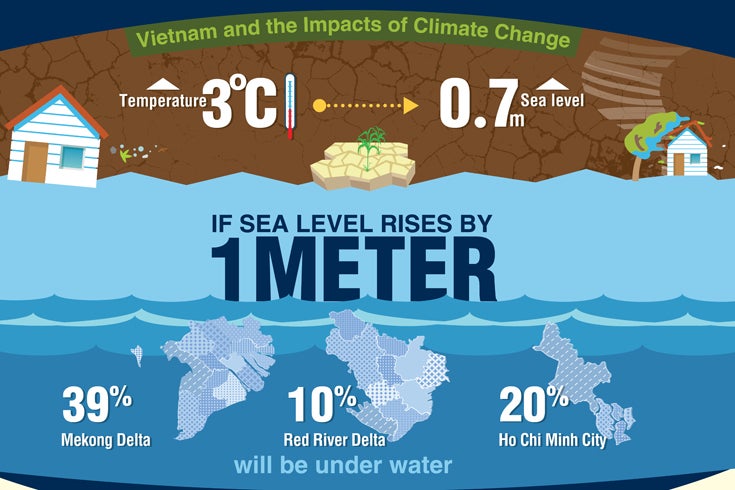
Y Cham, whom I met during a mission to plan for our support for the coffee rejuvenation project, comes from the Ede ethnic minority in Dak Lak, the major robusta coffee-producing province in the Central Highlands of Vietnam.
The long-time farmer shared with me his worries about his four hectares of coffee garden which had not been watered enough due to the prolonged drought.
“If I cannot harvest as much coffee as last year, I cannot sustain the studies of my daughter who is a student at medical college in Hanoi”.
The Central Highland, home of 500,000 hectares of coffee, has recently been affected by severe drought. The drought this year is considered most the most serious in the last 10 years. Over-irrigation and inefficient water use, compounded by increasing periods of drought, makes coffee farmers highly vulnerable, unless they are prepared to better adapt to the changing weather patterns.
Among the crucial factors for coffee yield, water, according to Y Cham, has become the biggest challenge in the priority order of “water, variety, funding, and science.” Water availability and advanced varieties resistant to the conditions of climate change are considered the most important factors.
The lack of water has recently been the topic of heated discussions of a coffee farmer partnership of nearly 250 members (which Y Cham helped set up), besides the application of good farming practices offered by the provincial extension service for coffee plantations.
The overuse of water for coffee has resulted in farmers having to drill to a depth of up to 60 meters to find groundwater - compared to 20 meters before. Above all, they are very worried about the prolonged drought this year as January to April is a crucial time in the growth of the coffee crop, when the coffee plants require more water from reservoirs or underground as rainfall only provides 25 percent of crop demand. In order to have high yields, coffee needs water to break the dormancy of flower buds, triggering blossoms and developing cherries.
Vietnam has been experiencing more frequent floods and drought, increased temperatures, intensified storms, and sea level rise. Farmers in the Red River and Mekong River Deltas are suffering from saltwater intrusion -- their livelihoods, which rely on rice and crops, are threatened.
Vietnam has made considerable development progress over the past few decades, all but eliminating extreme poverty in the country. While economic growth has created opportunities for people and businesses, the effects of climate change may slow down, halt, or even reverse these achievements unless measures are taken to mitigate such effects.
At the same time, Vietnam is at a stage in development where its people are seeking a higher quality of life. To meet these rising demands, Vietnam will have to develop significant new infrastructure, address an increase in both energy demand and rapid urbanization, and promote resilience measures to ensure Vietnam’s food and water security. These are all issues that are impacted by climate change and have an impact on the emissions profile of the country. The people are also recognizing the impacts that climate change has on Vietnam. A survey in 2010 carried out by the Hong Kong Shanghai Bank (HSBC) across 15 countries showed that 30% of survey respondents in Vietnam ranked climate change as their top concern among global issues (such as pandemic diseases, terrorism, and global poverty), the highest among all countries surveyed.
Working on climate change in Vietnam, I am encouraged at the efforts the government has made so far in terms of its policy and institutional reforms to address the main climate challenges of the country. The government’s review of climate change expenditure and investment in Vietnam, for which the World Bank Group has provided a helping hand, serves as a basis for enhancing the planning and prioritization process of the government’s budget process to promote climate action. The review shows that the government has made progress in mobilizing its own resources for climate change. However, given the magnitude of the problem, Vietnam will need to expand its resource base and increase the efficiency of the use of existing resources.
The review counts as a first step to enhancing the government resource allocation framework for climate change and green growth. The review promotes coherence across policies and programs by fostering a clear link between the State Budget and climate and green growth policy.
While many view this as a challenge in the coming years, I see this is as more of an opportunity for Vietnam - to begin showing that it is serious about promoting a climate resilient green growth development path. It is important to keep the momentum going. This coffee rejuvenation project will support Y Cham and coffee growers like him in improving farming techniques and above all on how to use water more efficiently for coffee growing.
Related:
Mainstreaming Climate Change Investment Key to Vietnam’s Response to Climate Change
Infographic: Smart Investment for Vietnam's Sustainable Future
The Climate Public Expenditure and Investment Review: Key findings and recommendations
Full report: The Climate Public Expenditure and Investment Review


Join the Conversation